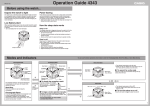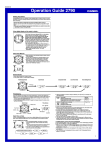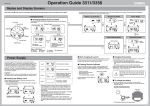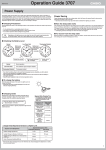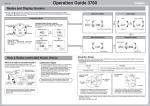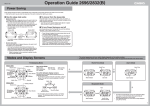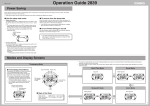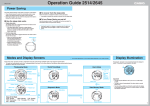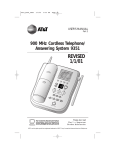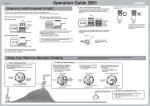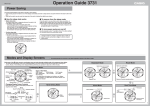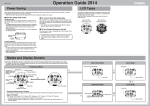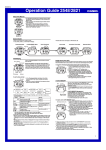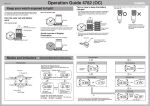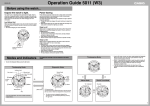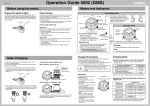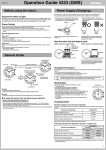Download Casio Watch MA0309-EA User's Manual
Transcript
Operation Guide 2730 MA0309-EA Power Saving The Power Saving feature of the watch is turned on at the factory. • Power Saving causes the watch to automatically enter a sleep state to save power whenever the watch is left in the dark. • Note that the watch may also enter the sleep state if the face is blocked from light by your sleeve. ❚ How the sleep state works There are actually two sleep state levels, a “display sleep state” and a “function sleep state”. • Display sleep state The display sleep state is triggered whenever the watch is left in the dark for three or four days. • Alarms and the hourly time signal continue to operate normally while the watch is in the display sleep state. Even when the watch is in the sleep state, digital-analog time coordination and auto signal receive are both performed. • Function sleep state The function sleep state is triggered whenever the watch is left in the dark for four days after the display sleep state is triggered. • Alarms and the hourly time are also disabled while the watch is in the function sleep state. In the function sleep state, analog timekeeping is disabled, so digital-analog time coordination is not performed. • Digital timekeeping functions continue to operate normally in the function sleep state. Power Saving Indicator PS ❚ To recover from the sleep state Place the watch in an area that is well-lit, press any button, or angle the watch towards your face to illuminate the display using the Auto Light. • It can take up to two seconds before the display re-appears after you place the watch in a well-lit area. ❚ To turn power saving on and off See the procedure under “Manually Setting the Time and Date” for information about turning off power saving. Leaving the watch in a drawer or anywhere else it is dark can cause the power saving mode to trigger in order to conserve battery power. Modes and Display Screens Each press of the C button sounds a confirmation tone and cycles through available modes in the sequence shown below. Timekeeping Mode • The watch automatically returns to the Timekeeping Mode if you do not perform any operation for about two or three minutes in the Alarm Mode (excluding the target alarm), e-DATA MEMORY Mode, or Hand Setting Mode. Alarm Mode World Time Mode (Illuminates display) button button button button City Code e-DATA MEMORY Mode Mode Name Alarm Number Data (Changes mode) Alarm Time Record Number World Time Switching Between Screens Each press of the button toggles the digital display between the Calendar Screen and Timekeeping Screen. Calendar Screen Timekeeping Screen Hand Setting Mode Stopwatch Mode Mode Name Time Stamp Mode Mode Name Day of the Week Month Hour Seconds Day Minutes PM Indicator (no indicator for AM) Days of the Week SU : Sunday WE : Wednesday SA : Saturday MO : Monday T H : Thursday TU : Tuesday, FR : Friday, Mode Name Measured Value Standby Screen 1 Operation Guide 2730 Power Supply The power supply of this watch uses a solar cell to generate electrical power, which is stored by a rechargeable battery. Using or storing the watch where it is not regularly exposed to light, or allowing it to be blocked from light by your sleeve as you are wearing it can cause the power of the rechargeable battery to run down. To ensure stable operation, be sure to allow the watch to be exposed to light as much as possible when you are wearing or storing it. Note that all data in memory and all settings are cleared whenever you allow the level of the rechargeable battery to drop to Level 4. ❚ Battery Indicator • Exposing the watch to direct sunlight or other strong light may cause the battery level indicator to momentarily indicate a level that is higher than the actual battery level. Because of this, you should wait for a short while after charging to check the battery level indicator. • Alarms and the hourly time signal cannot be turned on, and signal reception is disabled while the battery is at Level 3. • Signal reception will become enabled again when the battery is recharged up to Level 2. • Even after the battery drops to Level 4, watch operation will resume as soon as charging starts. However, you should wait until the battery reaches Level 2 before setting the time and date. ❚ Start charging at Level 3! If the Level 3 indicator starts to flash, it means that battery power is very low. Be sure to expose the watch to light for recharging as soon as possible after the Level 3 indicator starts to flash. Hi Mid Low C ❚ Recovering Indicator Level 1 Hi Mid Low C Level 2 Hi Mid Low C Normal operation enabled. Level 3 Hi Mid Low C Signal reception, tones (alarms, hourly time signal) display illumination, and digital display disabled. Level 4 Hi Mid Low C All functions, including digital timekeeping, disabled. Normal operation enabled. Illuminating the Display Manually In any mode, press the B button to illuminate the display for about 1.5 seconds. • The display does not illuminate if a setting screen (one with a flashing setting) is on the display. ❚ Charging Guide Avoid charging the watch in the following locations, and anywhere else the watch may become very hot. • On the dashboard of an automobile parked in the sun • Very close to an incandescent light source or other sources of heat • In a location exposed to direct sunlight for long periods Note that the display panel may become black under very high temperatures. This is temporary, and the display will appear normal again at lower temperatures. Starting from a full charge, the watch should be able to continue operating for about five months without further charging under the conditions described below. Depending on the light source you are using, the case of the watch may become quite hot during charging. Take care to guard against burn injury after charging. ❚ Charging the Battery Normal operation will return after the battery recovers. Example: Positioning the watch Solar Cell • The illustration shows the resin band model. ❚ Positioning Your Arm Correctly The auto light switch automatically illuminates the display for about 1.5 seconds whenever you angle the watch towards your face for reading, but only when it is dark. • The auto light switch does not illuminate the display when surrounding light is bright. The auto light switch illuminates the display in all modes. Turning the Auto Light Switch On and Off In the Timekeeping Mode, hold down the B button for about two seconds to toggle the auto light switch on (auto light switch on indicator displayed) and off (no indicator displayed). You may hear a faint rattling sound when you move the watch around. This sound is caused by the movement of a metal bulb that controls operation of the auto light switch, and does not indicate malfunction. Daily Use (All time values are approximate.) • Display Illumination: 1.5 seconds • Alarms: 10 seconds • Signal reception: 5 times • The following is the daily amount of charging required each day to support the operations under “Daily Use”. Environment (Luminosity) Charging Time Outdoor sunlight (50,000 lux) 5 min. Indoor sunlight (10,000 lux) 24 min. Outdoor overcast 48 min. (5,000 lux) Making sure the watch is regularly exposed to light ensures stable operation. Fluorescent indoor lighting (500 lux) 8 hr. Environment (Luminosity) Charging Time Level 4 \ Level 3 \ Level 2 \ Level 1 Outdoor sunlight (50,000 lux) 1 hr. 13 hr. 4 hr. Indoor sunlight (10,000 lux) 3 hr. 66 hr. 18 hr. Outdoor overcast (5,000 lux) 5 hr. −−− −−− Fluorescent indoor lighting (500 lux) 45 hr. −−− −−− • Note that the above charging times are for reference only. Actual charging time depends on a variety of environmental factors. Auto Light Precautions • Frequent use of the auto light can run down the battery. • The display may not illuminate immediately when you angle the With the watch on your Rotate your arm so the watch watch towards your face. This does not indicate malfunction. wrist, position it parallel is angled at about 40 degrees, • The display remains lit for about 1.5 seconds only, even if you with the ground. so you can read its face. leave the watch angled towards your face. • The display may illuminate unintentionally when you wear the watch on the inside of your wrist, when you shake your arm, or when you raise your arm. Be sure to turn off the auto light switch whenever you do not need display illumination. More than 40 • Keep the auto light switch turned off whenever you are wearing degrees the watch on the inside of your wrist. • Electro-static charge and magnetism can interfere with auto light operation and even make operation impossible. If this happens lower your arm to the starting position and then raise it again. If you still have trouble with display illumination, try lowering your • You should be wearing the watch on the outside of your wrist arm down to your side and then raise it to your face for reading. when using the auto light switch. • Make sure that the left (9 o’clock) and right (3 o’clock) sides of the watch are within ±15 degrees of being level with the ground. The auto light switch may not operate properly if the angle is greater. 1 Illuminating the Display with the Auto Light Switch Required Daily Charging Time • Charge Times Required to Advance to a Higher Level Point the solar panel (face) of the watch at a light source. • Remember that even a partial blockage of the solar cell reduces charging efficiency. If you use the light or alarms a number of times during a short period, the Recovering indicator may appear on the display to indicate that the following operations are disabled in order to allow battery power to recover. R Recovering • Display illumination Indicator • Alarm and hourly time signal • Analog timekeeping • Time calibration signal reception Display Illumination An LED light is used to illuminate the display for easy reading in the dark. An auto light switch automatically illuminates the display when you angle the watch towards your face for reading. ❚ Charging Precautions 2 Important! Auto light switch on indicator • The light may be difficult to see if you turn it on under bright sunlight. • If you press the B button or if an alarm operation starts while the display is illuminated, illumination will turn off. 2 Operation Guide 2730 How a Radio-controlled Watch Works What is a radio-controlled watch? Calibration Signal Your radio-controlled watch is designed to receive a time calibration signal that contains standard time data and adjust its current time setting accordingly. • The Japanese calibration signal (Call Sign: JJY) is maintained by the independent Japan Ministry of Posts and Telecommunications Communication Research Laboratory (CRL). It is a long wave signal transmitted 24 hours a day from the Mt. Otakadoya transmitter (40kHz) located in Tamura-gun, Fukushima Prefecture, and from the Mt. Hagane transmitter (60kHz) located on the border between Saga Prefecture and Fukuoka Prefecture. • The U.S. calibration signal (Call Sign: WWVB) is transmitted by the National Institute of Standards and technology from Fort Collins, Colorado. Transmitter Signal received using built-in antenna. Long-wave Calibration Signal Watch decodes received data and converts it to time data. Signal Data Decode Cesium Atomic Clock Watch Time Data Internally Time is adjusted according to time data. Reception Range This watch is designed to receive the standard time calibration signal of Japan (JJY) or of the United States (WWVB). The signal that is received depends on the current Home City setting. • For information about selecting a Home City, see “Setting the Time and Date Manually”. Home City Transmitter Either the Mt. Otakadoya signal (40kHz) or the Mt. Hagane signal (60kHz) TYO Fort Collins, Colorado signal LAX, DEN, CHI, NYC Transmitter Location 1000km Though the calibration signal is normally transmitted 24 hours a day, transmission may be interrupted occasionally due to maintenance, lightening, etc. 3000km 1000km 500km Mt. Hagane (60kHz) After the watch receives the time calibration signal, it performs internal calculations to determine the current time. Because of this, there may be an error of up to one second in the displayed time. Transmitter Location 500km Mt. Otakadoya (40kHz) Fort Collins 1000km • Under optimum conditions, the calibration signal should be receivable up to 1,000 kilometers from the transmitter. Note that the wave is relatively weak at distances greater than 500km, so reception may be poor at long distances. • Under optimum conditions, the calibration signal should be receivable up to 3,000 kilometers from the transmitter. Note that the wave is relatively weak at distances greater than 1,000km, so reception may be poor at long distances. • Geographic contours, nearby buildings, the season, the time of day, can even make reception impossible even when you are within range of the transmitter. • Best reception is possible late at night. Location Receiving the Calibration Signal ❚ Time Required for Reception ❚ Receive Icon Reception is difficult and may even be impossible in the locations described below. Avoid such locations when performing signal reception. • You should think of your watch operating like a radio or TV when it is receiving the calibration signal. There are two methods you can use to receive the time calibration signal. • Auto receive (Reception is performed automatically at midnight, 1:00, 2:00, 3:00, and 4:00 each morning.) • Manual receive (You initiate reception using a button operation.) • If reception is not successful for any of the normal auto receive times shown above, auto receive is performed one more time at 5:00 a.m. • The watch is set up for auto reception at the factory, so all you need to do is to place it in a location that allows good reception each night. Signal reception takes anywhere from about two to six minutes. • Note that when “AT” is specified as the frequency selection mode, signal reception can take up to 12 minutes. • See “Specifying the Transmitter Selection Mode” for more information. The receive indicator cycles from “Unstable” through “Stable” as shown below while reception is in progress. How far it cycles depends on the signal strength. Keep the watch in a location where reception isstable when it is in progress. Among or near buildings Near high-voltage lines ❚ Setting Up to Make Reception Easier Remove the watch from your wrist and place it somewhere so its top (12 o’clock side, where the antenna is located) is facing approximately in the direction of the signal transmitter. Keep it away from metal objects. ❚ Triggering Reception Manually In the Timekeeping Mode, hold down the D button for about two seconds until the watch beeps. • This indicates that manual receive has started. Ongoing reception is indicated by the icon and the receive indicator. Stopping Signal Reception Inside a vehicle (automobile, train, plane, etc.) In a location where there is radio interference (construction site, airport, etc.) Next to a household appliance or office equipment (TV, speaker, fax, PC, mobile phone, etc.) Press the D button. Unstable Stable • Even under optimum reception conditions, it can take about 10 seconds for reception to stabilize. • Use the receive icon to check reception status and to determine the best location for signal reception. • Note that weather, the time of day, surroundings, and other factors can all affect reception. • All other buttons besides D are disabled during signal reception. Resin Band Near mountains If you are experiencing problems with reception, move away from the types of locations described above to a location with better reception, and try again. Receive Icon Metal Band • Orienting the watch so it is sideways to the transmitter makes it more difficult to receive the signal. • Do not move the watch while it is receiving the calibration signal. When reception is successful The watch terminates reception and adjusts the current time. Next it beeps and then displays the date and time the adjustment was performed. • The icon on the display also indicates successful signal reception. • Following successful reception, the analog hands adjust automatically to the digital time. ❚ Analog Hands and Signal Reception When reception fails The watch does not adjust its current time setting, and displays “ERR” instead. • The display also returns to the normal timekeeping screen automatically if you do not perform any operation for about one or two minutes. Hour and Minute Hand These hands continue to operate normally. Second Hand This hand moves to the 12 o’clock position when reception starts. • It resumes normal movement after reception is complete. • Pressing a button to stop reception causes the second hand to move to the seconds count as kept by the digital display and resume normal operation. Note that the second hand does not move while signal reception is in progress. 3 Operation Guide 2730 ❚ Viewing the Last Reception Date and Time In the Timekeeping Mode, press the D button. This displays the date and time of the last successful signal reception. • The month and day screen and hour and minute screen alternate at two-second intervals. • To return to the Timekeeping Mode, press the D button again. • The display also returns to the normal timekeeping screen automatically if you do not perform any operation for about one or two minutes. Specifying the Transmitter Selection Mode When Tokyo (TYO) is selected as the Home City, you can select either of two different transmitters for reception. • For information about selecting a Home City, see “Setting the Time and Date Manually”. • The initial factory default settings of the watch are TYO (Tokyo) for the Home City, and AT (auto select) for the transmitter selection mode. 1. 2-second interval In the Timekeeping Mode, hold down the A button for about two seconds, until the current transmitter selection mode indicator flashes on the display. • This is the setting screen. • The second hand moves to the 12 o’clock position. 2. Press the D button to cycle through the available transmitter select mode settings, described below. • AT With this setting, the watch automatically selects either the Mt. Otakadoya signal (40kHz) or the Mt. Hagane signal (60kHz), whichever is strongest. • 40 JPN With this setting, the watch always receives the Mt. Otakadoya signal (40kHz). • 60 JPN With this setting, the watch always receives the Mt. Hagane signal (60kHz). Turning Auto Receive On and Off 1. • This is the setting screen. • The second hand moves to the 12 o’clock. 2. When the setting you want is displayed, press the A button twice to exit the setting screen. • At this time, the analog hands will adjust automatically to the digital time. • The display also will exit the setting screen automatically if you do not perform any operation for about two or three minutes. Press the C button three times. • This causes the current auto receive setting (On or OF) to flash on the display. 3. 3. In the Timekeeping Mode, hold down the A button for about two seconds, until the current transmitter selection mode indicator flashes on the display. (Three Times) Press the D button to toggle auto receive on and off. • On Auto receive is turned on. • OF Selecting this setting turns off auto receive and auto transmitter selection. 4. When the setting you want is displayed, press the A button twice to exit the setting screen. • At this time, the second hand will adjust automatically to the digital time. • The display also will exit the setting screen automatically if you do not perform any operation for about two or three minutes. Calibration Signal Reception Precautions Troubleshooting • Auto reception can be performed while the watch is in the Timekeeping Mode or World Time Mode only. • Receipt of a calibration signal causes the digital time to be adjusted first, followed by adjustment of the analog time. In order to ensure correct ajustment of the analog time, be sure to match the analog time with the digital time before performing a signal receive operation. • Note that analog timekeeping is not performed during signal reception, so the time indicated by the analog hands may be wrong. • Operating any button while auto reception is in progress will cause the watch to beep and then exit the receive operation. • Make sure you are within the range of the calibration signal transmitter before performing the reception operation. Remember that geographic contours, nearby buildings, the season, the time of day, can make reception impossible even when you are within range of the transmitter. • Proper reception may be impossible if there is something blocking the signal. If reception is unsuccessful, try again. • This watch is designed to adjust its current time setting in accordance with the calibration signal transmitted in Japan and the United States only. Note that you will need to make your own adjustments when using this watch outside of Japan or the United States, or in any area that is outside the range of one of the receivable time calibration signal transmitters. • When the watch is unable to adjust its time signal using the calibration signal for some reason, timekeeping accuracy is within ±15 seconds per month. • Strong electrostatic charge can cause timekeeping error. • Signal reception is cancelled if an alarm starts to sound while it is being performed. • The watch’s calendar shows dates up to the year 2099. Attempting a receive operation after that causes an error. Cause: Cannot perform manual reception. • Manual receive can be performed in the Timekeeping Mode only. • The Home City is set to a city other than TYO (Tokyo), NYC (New York), CHI (Chicago), DEN (Denver), or LAX (Los Angeles). Corrective Measures: • Perform manual receive in the Timekeeping Mode. • Change the Home City to TYO (Tokyo), NYC (New York), CHI (Chicago), DEN (Denver), or LAX (Los Angeles). Correctly set the Home City as detailed under “Setting the Time and Date Manually”. The icon is not on the display even though auto signal reception is turned on. Cause: • The icon appears after the watch successfully receives the calibration signal and adjusts the current time setting. • A single receive operation was not successful. • The watch is not in the Timekeeping Mode or World Time Mode when an auto reception time is reached. Corrective Measures: • Check to make sure the watch is in a location where it can receive the signal. • Place the watch in a location where reception conditions are good. • Make sure that the watch is in the Timekeeping Mode or World Time Mode during the auto reception times. • You performed manual reception, which clears the icon from the display. Time setting is incorrect following signal reception. Cause: • If the current time is advanced by one hour, it probably means that summer time is turned on (indicated by the DST indicator on the display). • If there is a large error in the setting, it probably means that the wrong Home City is selected. Corrective Measures: • Correctly configure the summer time and Home City settings as detailed under “Turning Summer Time On and Off” and “Setting the Time and Date Manually”. • If you cannot receive the calibration signal or if the current time setting is incorrect after signal reception, check the current setup of the watch. • The following are the watch’s factory default settings, which are configured automatically whenever you have the battery of the watch replaced. Transmitter Auto Japan transmitter select (40kHz/ 60kHz) Home City Tokyo Summer Time Auto switching (according to signal data) Auto Receive On 4 Operation Guide 2730 Using Summer Time (DST) World Time Mode World Time lets you display the current time in any one of 30 cities (29 time zones) around the world. • When you enter the World Time Mode, the screen for the city that was displayed when you last exited the mode appears first. • The seconds count in the World Time Mode is linked with the Timekeeping Mode seconds count. • The same 12-hour/24-hour format you select for the Timekeeping Mode time is also applied in the World Time Mode. City Search GMT City DifferCode ential City Name –11 In the World Time Mode, press the D button to scroll through city codes. • A short while after a city code appears, the display will change to show the current time in that city. • Holding down the D button scrolls the city codes at high speed. Turning Summer Time On and Off In the World Time Mode, use the D button to select the city whose summer time setting you want to change. Next, hold down the A button for two seconds. City Code Important! City Code List Summer time, or Daylight Saving Time (DST) as it is called in some countries, calls for setting clocks ahead one hour during the summer season. Note that the use of summer time depends on the country and even the local area. • If the World Time Mode time is incorrect, ajust the setting of the current time in the Timekeeping Mode. See “Setting the Time and Date Manually” for more information. World Time (Forward) • Pressing the A button in the World Time Mode displays the city code of the currently selected city for about two seconds. • This toggles summer time on and off. • The “DST” indicator appears on the display and timekeeping is advanced by one hour when summer time is turned on. • You can turn summer time on or off independently for each World Time Mode city. Note, however, that you cannot turn on summer time for the “GMT” city code or the city code selected as your Home City. HNL –10 Honolulu ANC –9 Anchorage GMT City DifferCode ential JRS +2 JED +3 THR +3.5 City Name Jerusalem Jeddah Teheran LAX –8 Los Angeles DXB +4 DEN –7 Denver KBL +4.5 Kabul CHI –6 Chicago KHI +5 Karachi NYC –5 New York DEL +5.5 Delhi CCS –4 Caracas DAC +6 Dakar RIO –3 DST Indicator Rio De Janeiro RGN +6.5 Dubai Yangon –2 BKK +7 Bangkok –1 Hong Kong HKG +8 GMT +0 Greenwich Mean Time SEL +9 Seoul LON +0 TYO +9 Tokyo Adelaide London PAR +1 Paris ADL +9.5 BER +1 Berlin SYD +10 Sydney ATH +2 Athens NOU +11 Noumea CAI +2 Cairo WLG +12 Wellington • The contents of the above table are current as of December 2002. • Time differentials in the above table are in accordance with Universal Time Coordinated (UTC). Viewing Time Stamp Records Time Stamp Mode The Time Stamp Mode lets you create and store up to 10 records, each of which contains the date (month and day) and time (hour, minute, second) that the data was stored. Time Stamp records serve as helpful memos when you need to remember the current date and time for some reason. • Entering the Time Stamp Mode causes a standby screen to appear. • The same 12-hour/24-hour format you select for the Timekeeping Mode time is also applied in the Time Stamp Mode. Switching Between Time Stamp Screens In the Time Stamp Mode, press the A button to toggle between the standby screen and the recall screen. Standby Screen Recall Screen • The recall screen initially shows the record number. After that, the display alternates between the recorded date and time at twosecond intervals. • Pressing the A button will not switch to the recall screen if there is no Time Stamp data currently stored in memory. 2-second interval Creating a Time Stamp Record While the Time Stamp standby screen is on the display, press the D button. • This causes the display contents to flash as the Time Stamp data (month, day, hour, minute, second) is stored in memory. • After data storage is complete, the display stops flashing and the standby screen reappears. • You can have up to 10 Time Stamp records in memory at one time. • Auto Data Replacement Creating a Time Stamp record when there are already 10 records in memory causes the oldest record in memory to be replaced by the new record. Standby Screen While the Time Stamp recall screen is on the display, press the D button to scroll the Time Stamp records. • Holding down the D button toggles at high speed. • The recall screen initially shows the record number. After that, the display alternates between the recorded date and time at twosecond intervals. • When you display the recall screen, the record that was displayed when you last recalled records appears first. If you have stored a new Time Stamp record since then, however, the new record appears first. Recall Screen Record Number Date (month, day) Recorded 2-second interval Deleting Time Stamp Records While the Time Stamp recall screen is on the display, press the A button and D button at the same time. • This causes “CLR” to flash on the display as all of the Time Stamp records are deleted. • After data delete is complete, the display stops flashing and the standby screen reappears. • Note that you cannot delete individual Time Stamp records. Time (hour, minute, second) Recorded Example: When there are five Time Stamp records in memory • Newest Record Record 5 [5] Record 4 [4] Record 1 [1] Record 3 [3] Record 2 [2] • Oldest Record 5 Operation Guide 2730 e-DATA MEMORY Mode You can use the e-DATA MEMORY Mode to store e-mail addresses, Web site URLs, and other information for instant recall whenever you need it. • Each record can contain up to 63 characters. • The theoretical maximum number of records is 40, but the actual maximum depends on the number contained in each record. If each record contains 63 characters, for example, you can store up to five records. If each record contains seven characters, you will be able to store up to 40 records. • Note that 40 is the maximum number of records, even if each record has fewer than six characters. • When you enter the e-DATA MEMORY Mode, the record that was displayed when you last exited the mode appears first. Viewing e-DATA MEMORY Records 1. Data While in the e-DATA MEMORY Mode, press the D button. • Each press of the D button scrolls through the records currently in e-DATA MEMORY. • Holding down the D button Record Number (Forward) scrolls at high speed. • As shown in the example below, scrolling through e-DATA MEMORY also displays a remaining memory screen. • If there is no data currently in e-DATA MEMORY, only the remaining memory screen appears. Example: When there are three e-DATA MEMORY records Record 1 Record 2 Record 3 When the record whose contents you want to view is on the display, press the A button. • This causes the record’s data to start scrolling from right to left, three characters at a time. • The end of the record is indicated by the “ ” symbol. • The data of the currently displayed record does not scroll when you press the A button if it contains two or fewer characters. Mode, press the A button and D button at the same time. (Back) Use the D (+) and B (–) buttons to scroll through characters at the cursor position until the one you want is displayed. • Holding down either button scrolls at high speed. • This will display the remaining memory screen. • If the remaining memory screen shows “0%”, it means that memory is full and further data storage is not possible. If you need to store more data, use the procedure under “Editing and Deleting e-DATA MEMORY Data” to delete data you no longer need. 2. 3. (Forward) • Supported Characters Lower Case Alpha: a to z Symbols: Upper Case Alpha: A to Z Numerals: 0 to 9 4. Press the C button to move the cursor to the next character to the right. First data character Hold down the A button for about two seconds until the first character of the data field starts to flash. • This is the setting screen. Remaining Memory Repeat steps 3 and 4 as many times as necessary to input all of the characters for the record you are creating. 5. 2. Creating an e-DATA MEMORY Data Record Remaining Memory 1. In the e-DATA MEMORY After inputting all of the characters you want, press the A button to save the record. • “SET” will flash on the display as the record is being saved. After the save operation is complete, the watch will exit the setting screen. • The display also will exit the setting screen automatically if you do not perform any operation for about two or three minutes. • Records are stored in the same sequence they are input. Editing and Deleting e-DATA MEMORY Data 1. In the e-DATA MEMORY Mode, use the D button to display the record you want to edit or delete. 2. Hold down the A button for about two seconds until the first character of the data field of the displayed record starts to flash. • This is the setting screen. 3. Stopwatch Mode The stopwatch measures elapsed time in units of 1/100 second up to 99 minutes, 59.99 seconds (100 minutes). When the maximum limit is reached, the elapsed time automatically returns to zero and timing continues from there. Performing Stopwatch Operations In the Stopwatch Mode, press the D button. • Each press of the D button starts or stops the stopwatch. Edit or delete the data as described below. 1/100 Second (Split/Reset) • To edit the record’s data Use the C button to move the cursor to location of the character you want to change, and then use the D and B buttons to scroll through characters until the one you want to change to is displayed. • To delete the record’s data Press down the D button and B button at the same time. This causes “CLR” to flash on the display as the record is deleted. • After deleting a record’s data, you can input new data, if you want. • The display also will exit the setting screen automatically if you do not perform any operation for about two or three minutes. 4. After editing or deleting the record, press the A button to exit the setting screen. • Deleting a record’s data deletes the record, and causes the remaining records to shift upwards. ❚ Elapse Time Measurement Start Stop Reset Cumulative Time Measurement Pressing the D button to restart the stopwatch without resetting it to all zeros resumes elapsed time measurement from where it was last stopped. ❚ Split Time Measurement Start Record split Release split Stop Reset (Start/Stop) Minutes Seconds ❚ 1st and 2nd Place Finishers Start 1st finisher 2nd finisher (Displays time of 1st finisher.) Displays time of 2nd finisher. Reset • Pressing A while timing is being performed freezes the current elapsed time on the display, but timing of the next split continues internally. This condition is indicated by the “SPL” (split) indicator on the display. • Changing to another mode while a split time is displayed cancels the split time operation. • Pressing the A button while timing is stopped resets the stopwatch to all zeros. 6 Operation Guide 2730 ❚ Setting an Alarm Time Alarm Mode 1. ❚ Viewing the Alarm Time or Target Alarm Time Alarm Name Using the Alarms Indicator ❚ Alarm Mode You can use the Alarm Mode to configure settings for various types of alarms (daily alarm, snooze alarm, target alarm) or for the hourly time signal. This watch has five alarms: three daily alarms, one target alarm, and one snooze alarm. In the Alarm Mode, press the D button to cycle through the alarm screens in the sequence shown below. • The alarm name indicator appears first, followed by the current alarm time setting. • Daily Alarm (AL1, AL2, AL3) With a daily alarm, the watch beeps for 10 seconds when the alarm time is reached. • Target Alarm (TAL) With a target alarm, the time remaining until the alarm time counts down on the display. • The watch beeps for 10 seconds when the alarm time is reached. • Snooze Alarm (SNZ) With the snooze alarm, the watch beeps for 10 seconds when the alarm time is reached, and up to seven times at fiveminute intervals thereafter. Pressing any button stops the beeper, but the alarm will sound again after five minutes. 2. In the Alarm Mode, use the D button to display the screen for the alarm whose time you want to set. Hold down the A button for about two seconds until the hour digits of the alarm time start to flash. Hour Alarm 1 (AL1) Alarm 2 (AL2) Alarm 3 (AL3) Hourly Time Signal (SIG) Snooze Alarm (SNZ) Target Alarm (TAL) Hour Alarm Indicator 3. Use the D (+) and B (–) buttons to change the hour setting. 5. (Back) • Holding down either button scrolls at high speed. • When setting the hour, make sure you specify AM (no (Forward) indicator) or PM (P) correctly when using 12-hour timekeeping, or that you specify the correct 24-hour time. • The same 12-hour/24-hour format you select for the Timekeeping Mode time is also applied in the Alarm Mode. ❚ Stopping the Alarm Beeper Using the Hourly Time Signal In the Alarm Mode, use the D button to display the screen for the alarm you want to turn on or off. Pressing any button while the beeper is sounding stops it. • In the case of the snooze alarm the alarm will sound again. The snooze indicator flashes while the snooze alarm is active (indicating that the alarm will sound again). • Use the procedure under “Turning an Alarm Time On and Off” to turn off the snooze alarm so it does not sound any more. The hourly time signal causes the watch to beep every hour on the hour. Press the A button to toggle the displayed alarm on or off. Alarm 1 Screen Snooze Alarm Screen (Back) (Forward) Minutes When the alarm time is the way you want, press the A button. • This exits the setting screen. • The display also will exit the setting screen automatically if you do not perform any operation for about two or three minutes. Target Time ❚ Turning an Alarm Time On and Off • Turning on an alarm causes the alarm indicator (ALM) to appear on its screen. The snooze alarm screen also has a snooze indicator (SNZ). Minutes Press the C button to move the flashing to the minute digits. • As with the hour setting, use the D (+) and B (–) buttons to change the minute setting. • Each press of C moves the flashing between the hour digits and the minute digits as shown below. • This is the setting screen. Displaying the setting automatically turns on the alarm. Alarm Time • About the Target Alarm Time Screen If the target alarm (TAL) is turned on, the alarm time appears first, followed by a screen that shows how much time remains until the alarm time is reached (target time). 4. ❚ Turning the Hourly Time Signal On and Off In the Alarm Mode, use the D button to display the screen for the hourly time signal (SIG). Important! Performing any of the following operations while the snooze indicator is flashing on the display cancels the snooze operation and stops the flashing. • Displaying the Timekeeping Mode setting screen • Displaying the Alarm Mode (snooze alarm) setting screen Press the A button to toggle the hourly time signal on or off. • Turning on the hourly time signal causes its indicator (SIG) to appear on the screen. Hourly Time Signal Screen ❚ Testing the Alarm Alarm Indicator Alarm Indicator Snooze Indicator In the Alarm Mode, hold down the D button to sound the alarm. Hourly Time Signal Indicator 7 Operation Guide 2730 5. Setting the Time and Date Manually You can use the following procedure to set the current time and date of the Home City that you have selected in the Timekeeping Mode. If you are planning to manually change both the digital and analog settings, be sure to adjust the digital setting first. Manually Setting the Time and Date 1. In the Timekeeping Mode, hold down the A button for about two seconds, until the current transmitter selection mode indicator flashes on the display. (Back) Use the D (+) and B (–) buttons to scroll through the city codes until the one you want to use as your Home City is displayed. • See “City Code List” for a complete list of city codes. • Holding down either button scrolls the city codes at high speed. • This is the setting screen. • See “Specifying the Transmitter Selection Mode” for more information about the transmitter selection mode. • The second hand moves to the 12 o’clock. 2. 3. 4. (Forward) City Code Press the C button to display the summer time setting. Press the D button to toggle summer time on or off. • OFF This setting turns off summer time, and displays the current time normally. • ON This setting turns on summer time. • Selecting this setting displays the DST indicator, and advances the current time setting by one hour. • A (AUTO) This setting enables auto summer time setting, which turns summer time on or off in accordance with the received time calibration signal. • This setting uses Japan summer time data when TYO is selected as the Home City code, and U.S. summer time data when NYC, CHI, DEN, or LAX is selected as the Home City code. • In the United States, Daylight Saving Time (summer time) is from 2:00 a.m. on the first Sunday in April until 1:00 a.m. on the last Sunday in October. • If you have any city other than HKG, TYO, SEL, NYC, CHI, DEN, LAX, ANC, or HNL selected for your Home City, you need to turn summer time on and off manually. Press the C button to change to display the home time setting screen. 6. Press the A button to display the time setting screen. • The first time setting that appears is for selecting 12/24hour timekeeping. 7. 12/24-hour format Use the C button to cycle through the time and date settings shown below. Each press of C causes the applicable setting to flash. Seconds 12/24-hour Format Seconds Hour Minutes Power Saving Day Month Year 8. • See “Using Summer Time (DST)” for more information about summer time. While the setting you want to change is selected (flashing), use the D and B buttons to change it as described below. • The currently selected city code will be flashing on the screen. To change the hour, minutes, year, month, or day setting To select 12/14-hour timekeeping While the 12/24-hour setting is selected, press D to toggle the timekeeping format between 12-hour (“12H” indicator) and 24-hour (“24H” indicator). 12/24-hour format To reset the seconds to 00 While the seconds are selected, press D to reset them to 00 in accordance with the time signal on the radio, TV, etc. • Pressing D while the seconds count is in the range of 30 to 59 resets it to 00 and also adds 1 to the minutes. Pressing D in the range of 00 to 29 resets the seconds count without changing the minutes. 9. (Back) Press the D button to increase the selected setting or the B button to decrease it. • Holding down either button scrolls the setting at high speed. • When setting the hour, make sure you specify AM (no indicator) or (Forward) PM (P) correctly when using 12Hour Seconds hour timekeeping, or that you Minutes specify the correct 24-hour time. • You can set a year in the range of 00 (2000) to 99 (2099). The day of the week is set automatically in accordance with the date you set. • The watch automatically makes adjustments for leap years and month lengths. Resets to 00 seconds To turn Power Saving On and Off While the Power Saving setting is selected, press the D button to toggle it ON and OFF. • Turning on Power Saving causes the Power Saving indicator to appear on the setting screen. Power Saving Indicator After all of the settings are configured the way you want, press the A button. • This exits the setting screen. • The display also will exit the setting screen automatically if you do not perform any operation for about two or three minutes. Digital-Analog Synchronization The watch automatically adjusts its analog setting to match the current digital time setting. • When adjusting the analog time, the hands may moves clockwise or counterclockwise. • Depending on how different the digital and analog time settings are, it may take some time for the analog hand setting procedure to be finished. • After adjustment of the hour and minute hand, the second hand will adjust automatically to the digital time. Manually Setting the Analog Time You can use the Hand Setting Mode to manually adjust the analog time when it does not match the digital time. Use the C button to enter the Hand Setting Mode. 1. 2. While in the Hand Setting Mode, hold down the A button for about two seconds until the second hand stops at the 12 o’clock position and “- 00 -” flashes on the digital display. If the second hand does not align with the 12 o’clock position automatically, use the D button to advance it by one second until it is aligned. • Holding down the D button moves the second hand at high speed. (Forward) 8 Operation Guide 2730 3. High-speed Lock Press the C button to advance to setting of the hour and minute hands. • While holding down the D button to start high-speed clockwise movement of the hands, press the B button to lock the highspeed movement. • While holding down the B button to start high-speed counterclockwise movement of the hands, press the D button to lock the high-speed movement. • High-speed movement of the hands will continue until it completes a 12-hour cycle, or until you press any button to stop it. • This causes the hour and minute digits to flash on the digital display. 4. Use the D (+) and B (–) buttons to adjust the hour and minute hands. • Each press of the D button moves the hands 20 seconds clockwise, while the B button moves them 20 seconds counterclockwise. • Holding down either button scrolls at high speed. (Back) 5. (Forward) When analog hands are set the way you want, press the A button. • This exits the setting screen and automatically synchronizes the minute hand with the current seconds count. • At this time, the second hand will adjust automatically to the digital time. • The display also will exit the setting screen automatically if you do not perform any operation for about two or three minutes. 9









